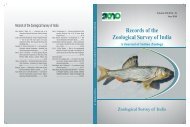Vol. 111 - Part I - Zoological Survey of India
Vol. 111 - Part I - Zoological Survey of India
Vol. 111 - Part I - Zoological Survey of India
Create successful ePaper yourself
Turn your PDF publications into a flip-book with our unique Google optimized e-Paper software.
MURMU et al. : A population survey <strong>of</strong> Rhesus monkeys and Hanuman langurs <strong>of</strong> Puri......Orissa, <strong>India</strong> 23<br />
trees or places for group counts. The monkeys found<br />
in other temples at Puri were supposed to be budded<br />
<strong>of</strong> from Jagannath temple groups. The population <strong>of</strong><br />
rhesus monkeys in these two districts is low in terms<br />
<strong>of</strong> habitable areas and food availability.<br />
The present survey revealed that hanuman langurs<br />
are more or less widely distributed in Puri and Khurda<br />
districts. The langurs mostly inhabit villages. About<br />
65% <strong>of</strong> the total langur groups recorded from these<br />
two districts is found in villages. The villages provide<br />
food and trees for shelter to the langurs. The langurs<br />
<strong>of</strong>ten raid crops and gardens in the villages. This has<br />
become a serious concern to the villagers but still the<br />
man-monkey conflicts are less in this part <strong>of</strong> Orissa.<br />
The people <strong>of</strong> the state are much tolerant towards the<br />
monkeys due to their sacred status, which they enjoy<br />
from the ancient times, though this attitude has eroded<br />
in many parts <strong>of</strong> the country. The earlier survey <strong>of</strong><br />
1978, 39 groups with 592 langurs was reported whereas<br />
during present survey 2097 langurs in 110 groups were<br />
recorded. Thus the population groups three and half<br />
times over a period <strong>of</strong> 25 years. In both the cases village<br />
groups were more in numbers than any other habitat.<br />
Twenty two village groups with 354 langurs were<br />
sighted in 1978 survey whereas during 2004 census 68<br />
groups with 1270 langurs were encountered. The village<br />
groups were increased about five times in 25 years.<br />
The 1978 survey was conducted in the month <strong>of</strong> May,<br />
the hottest month; this may be the reason for not<br />
locating all the groups. Analysis <strong>of</strong> field data <strong>of</strong> 1978<br />
survey, it was observed that at least 50% <strong>of</strong> the places<br />
where the survey team could not sighted the langurs<br />
but local people reported their presence. However,<br />
during 2004 survey the langurs were recorded from the<br />
places from where the local people reported their<br />
presence in the earlier survey.<br />
Nayagarh district, which is part <strong>of</strong> the then Puri<br />
district, was surveyed in 2005 (Chaudhuri et al., 2007)<br />
and the field investigation revealed that the rhesus<br />
population could not flourish during the last two<br />
decades. Only 4 new groups were added from 6 groups<br />
that were counted in 1978 survey at Nayagarh, though<br />
good forest cover (about 31%) still exists. Hanuman<br />
langur, the other primate species, nearly doubled from<br />
16 groups to 30 groups from 1978 to 2005. It is evident<br />
from the present study that the rhesus monkeys are<br />
less adapted to the habitat <strong>of</strong> Puri and Khurda than the<br />
langurs. The hanuman langur which is regarded as leaf<br />
eating monkey and use the upper canopy now found<br />
inhabiting all type <strong>of</strong> habitats and changed the feeding<br />
pattern, thus causing great threat to the bottom feeders,<br />
the rhesus monkeys.<br />
ACKNOWLEDGEMENTS<br />
Gratitude is expressed to the Director <strong>Zoological</strong><br />
<strong>Survey</strong> <strong>of</strong> <strong>India</strong> for his keen interest and given valuable<br />
suggestions for the improvement <strong>of</strong> the text. Our thanks<br />
are due to the forest department <strong>of</strong> Orissa and their<br />
<strong>of</strong>ficials for co-operation in the field survey.<br />
REFERENCES<br />
Alfred, J.R.B. & Sati, J.P. 1990. <strong>Survey</strong> & Census <strong>of</strong> the Hoolock gibbon in Garo hills, North-East <strong>India</strong>. Primates,<br />
31 : 299-306.<br />
Behura, B.K. and Guru, G.B. 1969. Wildlife <strong>of</strong> Orissa. Prakruti (Utkal Univ. J. Sc.), 6 : 95-126.<br />
Bhuinya S., Chaudhuri S. and Murmu A. 1993. <strong>Survey</strong> <strong>of</strong> non-human primates <strong>of</strong> the three districts <strong>of</strong> West<br />
Bengal. J. Bom. nat. Hist. Soc., 93(1-2) : 1-14.<br />
Chaudhury, A. 1990. Population dynamics <strong>of</strong> Hoolock gibbon (Hylobates hoolock) in Assam, <strong>India</strong>. Am. J. Primatol,<br />
20 : 37-41.<br />
Chaudhuri, S., Murmu, A. and Mazumdar, P.C. 2007. <strong>Survey</strong> <strong>of</strong> Non-human Primates <strong>of</strong> Nayagarh District, Orissa,<br />
<strong>India</strong>. Rec. zool. Surv. <strong>India</strong>, 107(<strong>Part</strong>-2) : 35-43.<br />
Mukherjee, R.P., Mukherjee, G.D. and Bhinya, S. 1986. Population tends <strong>of</strong> Hanuman langur in agricultural areas <strong>of</strong><br />
Midnapur district, West Bengal, <strong>India</strong>. Primate conserve., 7 : 53-54.<br />
Mukherjee, R.P., Chaudhuri, S. and Murmu, A. 1993. Population <strong>Survey</strong> <strong>of</strong> non-human primates (Mammalia) <strong>of</strong><br />
Tripura. Rec. zool. Surv. <strong>India</strong>, 93(3-4) : 557-564.
















